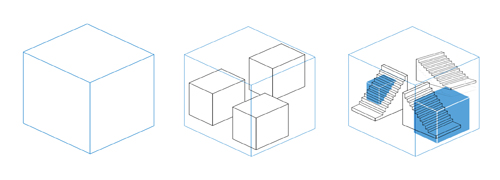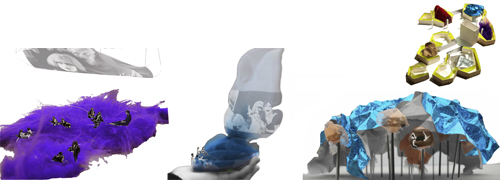Cinema of the Future 2013
Cinematic Acupuncture. The Cinema as Social and Creative Catalyst
19–27 April 2013
An initiative by ANCB The Aedes Metropolitan Laboratory, supported by Medienboard Berlin-Brandenburg and in cooperation with the project Berlinale goes Kiez by the 63rd International Film Festival Berlin.

Cinema of the Future 2013 is the fourth event in this Collaborative Project. This year's focus is on how the cinema, as a local meeting spot, can act as a catalyst for cohesive social change, using the Rollberg Cinema in Berlin-Neukölln as a case study.
Design Studio
The final presentation showcased the results of a week long design studio with the Universidad Europea de Madrid, led by Angel Luis Fernández, and the Dessau School of Architecture, led by Sam Chermayeff. The participants conducted both on-site research and design work at the ANCB studio space to develop an analysis of the urban context and propose an architectural/urban intervention for the Rollberg Cinema and its surroundings. The central focus of the studio was: how can architecture and design contribute to the survival of a local cinema in times of ever increasing competition and in doing so activate the surrounding neighbourhood?
Collaborative Project: Cinema of the Future
Cinema of the Future encourages a continuous debate about the role of cinema in public urban space in the Berlin region. Since the series began in 2010, ANCB has realised three successful design studios with international architecture students, examining the role of the cinema in the future urban public space of the city in 2010, expanded sociocultural and socio-economic programmes in 2011 and the future of the independent arthouse cinema as a critical element of the city's cultural offering in 2012.
Design Studio Results
Project Group 1 - Rolling Kino
by Paula Currás, Vitaly Ozerov, Enrique Ventosa, Xinyao Zhang

Thinking of the cinema of the future as more "permeable" and "cinematic", integrating in the constantly changing city, rather than "hidden" and "static", we proposed to adapt Rollberg Kino to these qualities and abilities.
Firstly, we removed the projection room located in the entrance and we made it migrate as a rolling cinema through Neukölln district and therefore, use the available space as the headquarters of this action and as the social laboratory for conflicts and debates.
The Rolling Kino will be a constantly migrating cinema which will adapt to existing infrastructures and use them as temporal stations that will work during the day as exchange information points, and temporal projection rooms at night.
In terms of existing cinemas in Neukölln and the influence of Rollberg Kino, a new business brand is generated in the city scale by a virtual platform that brings people together, local business, makes the neighborhood visible and all those available infrastructures that we catalogued based on specific parameters. We occupy these spaces using the cinema’s physical and abstract symbols as a tool to recreate the feeling and idea of the cinema.
We approach the city with small actions that will generate a feeling of the cinema and that will help to develop a better relation between the cinema and the citizens.
by Elena Zhyzhonkova, Michael Tsui, Raúl Almenara, Roberto Bouza

The first question that we asked ourselves when we started work was “How can architecture and design contribute to the survival of an independent cinema in times of ever increasing competition and in doing so activate the surrounding neighbourhood?”
The research started from the analysis and the individuation of places and the functions of cinema. We came across a number of problems but it seemed clear that in our project we did not want to demolish this cinema but to preserve, change, develop and improve it.
Our first goal was to solve the issue of the cinema’s location - within an unattractive shopping centre and a borough council office – in solution to which we tried to improve the design, to expand and to create new public interaction space.
Both the design of the interior and the exterior was based on idea of fragmentation. Strips of fragments of film would bind interior spaces with exterior spaces. By linking and covering the existing foyer with the courtyard we improved the open space. In addition to the cinema, we created spaces for lectures, exhibitions and meetings through the use of moveable walls, which can be arranged depending on events.
Linking the cinema with the city, we thought of making the surrounding area more attractive and creating strips from fragments of film, which lead people from different parts of the city to the cinema.
by Yananan, Kei, Lu

The project was tackled starting from what we thought to be the ‘four key points’: business service, urban presences, social engagement and architectural performance.
After having analyzed the problems that Rollberg Kino faces, we concluded that the cinema was not attracting many people due to its location, its being camouflaged within a mixed-use complex and its lack of big public spaces.
Starting from here, we developed a concept in three phases:
Today: the conventional cinema
Tomorrow: opening up of the outer skin = cinema boxes + community space
Future: breaking of ‘the wall’, opening the cinema as the entire community space + temporary cinema.
Under a business aspect, Communema will offer the same possibilities of a conventional cinema but it will also add more opportunities in economical gains by the selling of goods, food or drink, and also by the use of the outside screen for advertising.
As regarding the social aspect, the cinema will bring a new young generation of people interested in the new idea of cinema and in the community approach of the project.
On regards to the architectural aspect, the cinema room was simplified to ‘white boxes’ within the clear glass façade, whose transparency will attract and encourage people to use the public lobby space as the community space for social engagement in various activities. The white boxes could also be covered by screens, working in this way as the community’s information center.
by Hila Gordon, Camila Leal, Sara Ouass, Belén Rodero

Why do we watch movies in cinemas in such a rigid and conventional way, whereas at home we sit, lie down, move and feel comfortable?
This arrangement comes from XVII-XIX century’s theatres that had to fit with their needs.
Does a cinema room to be as it is nowadays? Could we just reduce it to a projector, a surface to project and a viewer?
Starting from these premises, we explored the relations between these three components, analyzing the opportunities to create different experiences that can affect the viewer by changing the position of the body and the projection medium.
In particular, we explored some of these relations in a few examples: atmospheric room where steam acts as screen and viewers can introduce themselves in hot water, absorbent room where a flexible floor absorbs you, scattered room, where the viewer acts as the projector and chose the surface to project…
Rollberg Kino could work as a platform where artists are invited each four or five months to think about cinema experience.
How could a cinema experience turn into a social experience? The surroundings of Rollberg Kino allow to have a lot of sound without disturbing too much. Therefore, this platform could also be used by the neighborhood to celebrate their events such as Turkish weddings, music concerts, etc.
by Ines Cedron Gragera, Álvaro Gonzalez-Onieva Olaso, Diego Pelayo Penche Perez
Once the area in which the cinema is located was studied, it resulted quite clear that there were two different atmospheres. We found the main entrance to be situated in a dull and narrow street. While on one hand there was a possibility to reach the cinema through a shopping center, which was accessed through a much more frequented street, on the other hand, the cinema seemed to be hidden in the far end of the center. For this reason we opted to release the cinema from the closed environment it belongs to and give it a transparent condition.
We found the cinema to have little activity during certain hours of the day, therefore we decided to give the cinema an upper beat all day long. This was done by including new uses to expand the renting activity: workshop areas and projecting rooms, where young students can create and expose their cinematographic art.
By offering new spaces to a wider range of people, the cinema becomes an interface for the neighborhood.
by Marina Coelho, Sara Yamin

The project “In Between” is the result of our exploration in the dialogue between private and public, between the cinema and the city. A delicate dialogue that should not forget the intriguing character of the Rollberg Kino towards the people of its neighbourhood.
The solution was looked for in the coexistence of a regular cinema and some private rooms that would have a direct contact with the outside public space. Under this perspective, other public spaces in the surrounding of the building were explored, thinking on their potentials for hosting other private cinemas.
As in the rest of the intervention, since the beginning, these were thought to be made of containers, whose modularity could be exploited in many different ways.
by Nusair Niazi

The intervention was developed keeping in mind one of the major problems of Rollberg Kino in Neukölln, Berlin, which is its location. The cinema is located on the back end of the building, which is mostly used for commercial purposes, which means that after the office hours it becomes empty contributing negatively on the cinema.
On a smaller scale, the project consists of a bench that will stand in the centre of the lobby area of the cinema. The organic-shaped bench will provide seating for small groups of people, making the lobby more vibrant and more comfortable for social interaction. It will grow out of the lobby, in all directions, acting as an attractor thanks to the interactive surface of which it will be made.
On a larger scale, throughout the neighbourhood of Neukölln and other parts of Berlin, posters and benches of the same interactive surface will be installed. These posters will offer free wifi locations. At the same time, the user will have to download an application that will advertise the cinema by showing the constantly updated schedule of the films being screened at the cinema. To create an interest amongst the young generation of the Neukölln area, video-watching devices will be installed in the area. They will be designed on the idea of people. It will not give a cinematic experience but it will create an interest among the non-privileged of the neighborhood.
by Fernando Cremades Pons, Carlos Ramirez Pantanella
Cinema is a controversial art. It is no more a place for social reunion but a place where spectator shows a passive attitude. Indeed, we do believe that desires are artificial: cinema does not give us what we desire but it tells us what to desire.
Therefore, our cinema of the future is based on 4 elements.
1. Business survival. We proposed personalized cinema consumption; where the spectator does not know what he/she is going to see but he/she knows he/she will like it.
2. Urban presence. The showrooms will be provided with an entry along the edge of the plot, and a common exit towards the courtyard where social interaction will take place.
3. Social engagement. Mapping the spectators’ desires throughout social networks will allow us to create social combinations of tastes and affinities.
4. Architectural performance. Movies are projected in different and adaptable sized cells, providing a fragmented cinema, covered with an acoustics isolating fabric.
by Tzahi Aslan, Alberto Rodríguez, Raquel Serrano

Beginning with an analysis about how the neighbouhood works, in order to understand the problems linked to the bad functioning of the cinema, we realized that there are no bars around. Keeping this in mind and taking advantage of the situation of having the biggest employment agency in Berlin above the cinema, our intervention evolved around the idea of creating a Cinema|Bar.
We began by exploding the box in which the cinema is contained. In this way, the space turns towards the street, working as a meeting point for people from the neighbourhood, workers or visitors. Whereas some different shops deal with the street and the cinema with the inside, the bar is what happens in between the cinema and the street.
Architecture will implement a variety of different possibilities to enjoy, adapting to people's necessities. Some futuristic panels will move through a metal grid to create all those different possibilities and spaces.
Finally, from an urban perspective, people will be attracted to our area thanks to some urban elements that will be located in the main streets and in the ones around allowing us to extend our intervention to the surroundings.
by Eugenio Fernández Sánchez, Victor Nouman, Álvaro Carrillo Eguílaz
”Home” is usually understood as the space where private citizens’ activities take place. Instead of this model, we proposed a “dislocated home” in the city. In this context the Kino could be the living room of this new "home" because of its capacity to provide “identity” and the social role of this place.
Concept: To transform the cinema into a space for collective experiences that works with identity
Architecture: To transform the projection room in a space that integrates other activities, so the spectator passes from a passive and individual attitude to a collective consciousness. Instead of one entrance and different exits, we propose one entrance to each room an only one exit.
The intervention will be developed in three phases:
. Thematic rooms: in these rooms the cinema is mixed with different activities such as a picnic, spot, personal relationships...
. Discussing pool: all the rooms converge in this central space intended to be a forum
. Tuning identity: this is the existing cinema, a space where everyone can become any character of the movies they previously saw, before moving back to the city
Urban strategies
The bar inside the cinema will be connected within a network of local bars in the neighborhood which cyclically activate the local business. The smell of food and popcorn will be projected to the exterior to attract people. There will also be a rolling cinema kit that can be moved to different places for special events and summer cinema. We propose a system of mobile sign banners in the cinema surroundings. People can send their designs and opinions via an SMS that will be printed and uploaded. Tickets will be sold in different places in the neighborhood, so everyone who wants to buy an entrance will interact with local people. A big balloon above the Kino will act as visual reference.
ANCB Programme
Theme
#identityinplace
Enquiry Programme
#knowledgespaces
Collaborative Project
#cinema
ANCB Partners

